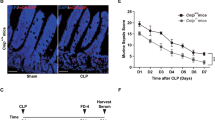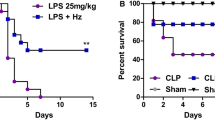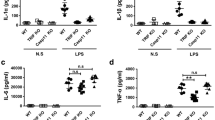Abstract
Antimicrobial peptides possess a myriad of molecular properties including bacterial killing and the regulation of many aspects of innate immunity. Cathelicidins are a group of antimicrobial peptides widely investigated by the scientific community. Many studies have focused on the bactericidal and pro-inflammatory roles of cathelicidins. Because the role of endogenous cathelicidin expression remains obscure in deep-seated systemic infections, we induced sepsis in cathelicidin knockout and wild-type (WT) mice by cecal ligation and puncture, performing transcriptome screening by DNA microarray in conjunction with other immunologic assays. Cathelicidin-deficient mice showed increased survival compared to WT mice in this established experimental model of polymicrobial sepsis, in association with upregulation of certain key inflammatory response genes. Therefore, cathelicidins can exert both pro- and anti-inflammatory activities depending on the disease and cellular context.
Key messages
-
The role of cathelicidin in a CLP model is investigated using cathelicidin-KO mice.
-
Cathelicidin-KO mice show an enhanced immune response and improved survival rates.
-
An anti-inflammatory effect of cathelicidin is likely to be detrimental for CLP.
-
Cathelicidin-KO mice show upregulation of genes associated with increased plasma levels of pro-inflammatory Ils.
-
Cathelicidins appear to have both pro- and anti-inflammatory properties.




Similar content being viewed by others
References
Zaiou M, Gallo RL (2002) Cathelicidins, essential gene-encoded mammalian antibiotics. J Mol Med (Berl) 80:549–561
Ramanathan B, Davis EG, Ross CR, Blecha F (2002) Cathelicidins: microbicidal activity, mechanisms of action, and roles in innate immunity. Microbes Infect 4:361–372
Durr UH, Sudheendra US, Ramamoorthy A (2006) LL-37, the only human member of the cathelicidin family of antimicrobial peptides. Biochim Biophys Acta 1758:1408–1425
Gallo RL, Kim KJ, Bernfield M, Kozak CA, Zanetti M, Merluzzi L, Gennaro R (1997) Identification of CRAMP, a cathelin-related antimicrobial peptide expressed in the embryonic and adult mouse. J Biol Chem 272:13088–13093
Gudmundsson GH, Agerberth B, Odeberg J, Bergman T, Olsson B, Salcedo R (1996) The human gene FALL39 and processing of the cathelin precursor to the antibacterial peptide LL-37 in granulocytes. Eur J Biochem 238:325–332
Pinheiro da Silva F, Machado MC (2012) Antimicrobial peptides: clinical relevance and therapeutic implications. Peptides 36:308–314
Nizet V, Ohtake T, Lauth X, Trowbridge J, Rudisill J, Dorschner RA, Pestonjamasp V, Piraino J, Huttner K, Gallo RL (2001) Innate antimicrobial peptide protects the skin from invasive bacterial infection. Nature 414:454–457
Iimura M, Gallo RL, Hase K, Miyamoto Y, Eckmann L, Kagnoff MF (2005) Cathelicidin mediates innate intestinal defense against colonization with epithelial adherent bacterial pathogens. J Immunol 174:4901–4907
Chromek M, Slamova Z, Bergman P, Kovacs L, Podracka L, Ehren I, Hokfelt T, Gudmundsson GH, Gallo RL, Agerberth B et al (2006) The antimicrobial peptide cathelicidin protects the urinary tract against invasive bacterial infection. Nat Med 12:636–641
Huang LC, Jean D, Proske RJ, Reins RY, McDermott AM (2007) Ocular surface expression and in vitro activity of antimicrobial peptides. Curr Eye Res 32:595–609
Oren Z, Lerman JC, Gudmundsson GH, Agerberth B, Shai Y (1999) Structure and organization of the human antimicrobial peptide LL-37 in phospholipid membranes: relevance to the molecular basis for its non-cell-selective activity. Biochem J 341(Pt 3):501–513
Ciornei CD, Sigurdardottir T, Schmidtchen A, Bodelsson M (2005) Antimicrobial and chemoattractant activity, lipopolysaccharide neutralization, cytotoxicity, and inhibition by serum of analogs of human cathelicidin LL-37. Antimicrob Agents Chemother 49:2845–2850
Larrick JW, Hirata M, Balint RF, Lee J, Zhong J, Wright SC (1995) Human CAP18: a novel antimicrobial lipopolysaccharide-binding protein. Infect Immun 63:1291–1297
Ries M, Schuster P, Thomann S, Donhauser N, Vollmer J, Schmidt B (2013) Identification of novel oligonucleotides from mitochondrial DNA that spontaneously induce plasmacytoid dendritic cell activation. J Leukoc Biol 94:123–135
Wewers MD, Sarkar A (2009) P2X(7) receptor and macrophage function. Purinergic Signal 5:189–195
Coffelt SB, Tomchuck SL, Zwezdaryk KJ, Danka ES, Scandurro AB (2009) Leucine leucine-37 uses formyl peptide receptor-like 1 to activate signal transduction pathways, stimulate oncogenic gene expression, and enhance the invasiveness of ovarian cancer cells. Mol Cancer Res 7:907–915
Yin J, Yu FS (2010) LL-37 via EGFR transactivation to promote high glucose-attenuated epithelial wound healing in organ-cultured corneas. Invest Ophthalmol Vis Sci 51:1891–1897
Tjabringa GS, Ninaber DK, Drijfhout JW, Rabe KF, Hiemstra PS (2006) Human cathelicidin LL-37 is a chemoattractant for eosinophils and neutrophils that acts via formyl-peptide receptors. Int Arch Allergy Immunol 140:103–112
Niyonsaba F, Iwabuchi K, Someya A, Hirata M, Matsuda H, Ogawa H, Nagaoka I (2002) A cathelicidin family of human antibacterial peptide LL-37 induces mast cell chemotaxis. Immunology 106:20–26
Salzer S, Kresse S, Hirai Y, Koglin S, Reinholz M, Ruzicka T, Schauber J (2014) Cathelicidin peptide LL-37 increases UVB-triggered inflammasome activation: possible implications for rosacea. J Dermatol Sci 76:173–179
Nagaoka I, Suzuki K, Niyonsaba F, Tamura H, Hirata M (2012) Modulation of neutrophil apoptosis by antimicrobial peptides. ISRN Microbiol 2012:345791
von Kockritz-Blickwede M, Goldmann O, Thulin P, Heinemann K, Norrby-Teglund A, Rohde M, Medina E (2008) Phagocytosis-independent antimicrobial activity of mast cells by means of extracellular trap formation. Blood 111:3070–3080
Barbeiro DF, Barbeiro HV, Zampieri FG, Cesar Machado MC, Torggler Filho F, Gomes Cunha DM, Goulart AC, Velasco IT, Monteiro da Cruz Neto L, Possolo de Souza H et al (2013) Cathelicidin LL-37 bloodstream surveillance is down regulated during septic shock. Microbes Infect 15:342–346
Jeng L, Yamshchikov AV, Judd SE, Blumberg HM, Martin GS, Ziegler TR, Tangpricha V (2009) Alterations in vitamin D status and anti-microbial peptide levels in patients in the intensive care unit with sepsis. J Transl Med 7:28
Wichterman KA, Baue AE, Chaudry IH (1980) Sepsis and septic shock--a review of laboratory models and a proposal. J Surg Res 29:189–201
Livak KJ, Schmittgen TD (2001) Analysis of relative gene expression data using real-time quantitative PCR and the 2(-Delta Delta C(T)) Method. Methods 25:402–408
Martin L, van Meegern A, Doemming S, Schuerholz T (2015) Antimicrobial Peptides in Human Sepsis. Front Immunol 6:404
Mookherjee N, Rehaume LM, Hancock RE (2007) Cathelicidins and functional analogues as antisepsis molecules. Expert Opin Ther Targets 11:993–1004
Pinheiro da Silva F, Gallo RL, Nizet V (2009) Differing effects of exogenous or endogenous cathelicidin on macrophage toll-like receptor signaling. Immunol Cell Biol 87(6):496–500
Kingsley SM, Bhat BV (2016) Differential Paradigms in Animal Models of Sepsis. Curr Infect Dis Rep 18:26
Danka ES, Hunstad DA (2015) Cathelicidin augments epithelial receptivity and pathogenesis in experimental Escherichia coli cystitis. J Infect Dis 211:1164–1173
Chromek M, Arvidsson I, Karpman D (2012) The antimicrobial peptide cathelicidin protects mice from Escherichia coli O157:H7-mediated disease. PLoS One 7:e46476
Audrain B, Ferrieres L, Zairi A, Soubigou G, Dobson C, Coppee JY, Beloin C, Ghigo JM (2013) Induction of the Cpx envelope stress pathway contributes to Escherichia coli tolerance to antimicrobial peptides. Appl Environ Microbiol 79:7770–7779
Cole JN, Nizet V (2016) Bacterial evasion of host antimicrobial peptide defenses. Microbiol Spectr 4. doi:10.1128/microbiolspec.VMBF-0006-2015
Thomassin JL, Brannon JR, Kaiser J, Gruenheid S, Le Moual H (2012) Enterohemorrhagic and enteropathogenic Escherichia coli evolved different strategies to resist antimicrobial peptides. Gut Microbes 3:556–561
Cirioni O, Giacometti A, Ghiselli R, Bergnach C, Orlando F, Silvestri C, Mocchegiani F, Licci A, Skerlavaj B, Rocchi M et al (2006) LL-37 protects rats against lethal sepsis caused by gram-negative bacteria. Antimicrob Agents Chemother 50:1672–1679
Beaumont PE, McHugh B, Gwyer Findlay E, Mackellar A, Mackenzie KJ, Gallo RL, Govan JR, Simpson AJ, Davidson DJ (2014) Cathelicidin host defence peptide augments clearance of pulmonary Pseudomonas aeruginosa infection by its influence on neutrophil function in vivo. PLoS One 9:e99029
Coorens M, Scheenstra MR, Veldhuizen EJ, Haagsman HP (2017) Interspecies cathelicidin comparison reveals divergence in antimicrobial activity, TLR modulation, chemokine induction and regulation of phagocytosis. Sci Rep 7:40874
Pinheiro da Silva F, Machado MC (2017) The dual role of cathelicidins in systemic inflammation. Immunol Lett 182:57–60
Wan M, van der Does AM, Tang X, Lindbom L, Agerberth B, Haeggstrom JZ (2014) Antimicrobial peptide LL-37 promotes bacterial phagocytosis by human macrophages. J Leukoc Biol 95:971–981
Peterson PK, Gekker G, Hu S, Sheng WS, Anderson WR, Ulevitch RJ, Tobias PS, Gustafson KV, Molitor TW, Chao CC (1995) CD14 receptor-mediated uptake of nonopsonized Mycobacterium tuberculosis by human microglia. Infect Immun 63:1598–1602
Muro M, Koseki T, Akifusa S, Kato S, Kowashi Y, Ohsaki Y, Yamato K, Nishijima M, Nishihara T (1997) Role of CD14 molecules in internalization of Actinobacillus actinomycetemcomitans by macrophages and subsequent induction of apoptosis. Infect Immun 65:1147–1151
Lipovsky MM, Gekker G, Anderson WR, Molitor TW, Peterson PK, Hoepelman AI (1997) Phagocytosis of nonopsonized Cryptococcus neoformans by swine microglia involves CD14 receptors. Clin Immunol Immunopathol 84:208–211
Devitt A, Moffatt OD, Raykundalia C, Capra JD, Simmons DL, Gregory CD (1998) Human CD14 mediates recognition and phagocytosis of apoptotic cells. Nature 392:505–509
Nakagawa Y, Gallo RL (2015) Endogenous intracellular cathelicidin enhances TLR9 activation in dendritic cells and macrophages. J Immunol 194:1274–1284
Pinheiro da Silva F, Medeiros MC, Dos Santos AB, Ferreira MA, Garippo AL, Chammas R, Caldini E, Velasco IT, Possolo de Souza H, Machado MC (2013) Neutrophils LL-37 migrate to the nucleus during overwhelming infection. Tissue Cell 45:318–320
Munoz M, Craske M, Severino P, de Lima TM, Labhart P, Chammas R, Velasco IT, Machado MC, Egan B, Nakaya HI et al (2016) Antimicrobial peptide LL-37 participates in the transcriptional regulation of melanoma cells. J Cancer 7:2341–2345
Acknowledgements
FPS is supported by FAPESP, the São Paulo Research Foundation (grant no. 2015/00892-4).
Author information
Authors and Affiliations
Corresponding author
Ethics declarations
All experiments were performed when animals were 8–12 weeks old and protocols followed in accordance with the University of São Paulo Faculty of Medicine Animal Facility guidelines through protocols approved by their ethics committee.
Conflict of interest
The authors declare that they have no conflict of interest.
Electronic supplementary material
Supplementary Figure 1
(PDF 583 kb)
Rights and permissions
About this article
Cite this article
Severino, P., Ariga, S.K., Barbeiro, H.V. et al. Cathelicidin-deficient mice exhibit increased survival and upregulation of key inflammatory response genes following cecal ligation and puncture. J Mol Med 95, 995–1003 (2017). https://doi.org/10.1007/s00109-017-1555-z
Received:
Revised:
Accepted:
Published:
Issue Date:
DOI: https://doi.org/10.1007/s00109-017-1555-z




